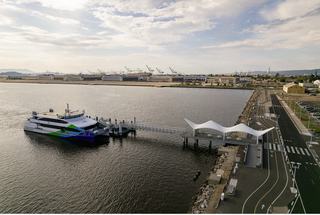Commuting in Alameda

Photo Credit: The City of Alameda
Convenient Travel Options
Alameda offers many efficient commute and transportation choices beyond driving solo—ideal for varying destinations:
Ferry
The San Francisco Bay Ferry provides four routes linking Alameda (Main Street, Seaplane Lagoon, Harbor Bay) with San Francisco and Oakland, with typical crossings taking 15–30 minutes depending on the terminal. Adult fares range around $4.90 per ride and can be paid via Clipper, which is widely accepted across Bay Area transit. Ferries offer traffic-free, scenic commutes and remain a commuter favorite in Alameda communities.
Alameda Water Shuttle (to Oakland)
The Alameda Water Shuttle offers a free, 5–7 minute ride across the Oakland Estuary between Alameda Landing and Jack London Square. It’s ADA accessible and bike-friendly, with space for up to 31 passengers and 14 bikes. Running Tuesday through Sunday, it makes up to 63 trips a day, making it a quick, reliable way to travel between the two waterfronts.
Transit (Buses & BART)
AC Transit operates both local and Transbay bus services, connecting Alameda to Oakland, Berkeley, and San Francisco via Salesforce Transit Center. Alameda residents also have access to regional services like the Dumbarton Express, which uses the Dumbarton Bridge to connect to San Mateo and Santa Clara areas.
Regional Rail and Shuttles
Nearest BART stations—Lake Merritt, 12th Street (Oakland), and Fruitvale—are accessible via tube crossings, offering rail connections throughout the Bay Area. The Oakland–Alameda Water Shuttle offers a free, bike-friendly connection between Alameda Landing and Jack London Square. Longer-distance commuters can tap into ACE (Altamont Corridor Express) or Amtrak Capitol Corridor via Oakland or nearby hubs.
Rideshare and Car Share
Alameda County supports car-sharing platforms like Zipcar, Getaround, and peer-to-peer services, plus rideshare match programs.
Car, Carpool, and Vanpool
Driving remains an option, particularly for longer commutes. Alameda County offers priority parking for carpoolers and supports vanpool programs to reduce drive‑alone trips. Alameda commuters can take advantage of express lanes on corridors like I‑680 and I‑580 for faster travel.
Biking
Alameda supports extensive sidewalks and bike routes across the island, encouraging residents to travel more sustainably. Efforts through 511, Bike East Bay, and city planning promote biking for commuting and errands. The Alameda County Transportation Demand Management (TDM) program also encourages biking and offers bike parking resources to employers.
Nearby Cities & Distances
1. Alameda to San Francisco
- Best Options: Ferry (from Main Street, Harbor Bay, or Seaplane Lagoon terminals) or bike-to-BART via Oakland.
- Time: Ferry crossing ~15–30 minutes; including biking or prep time, total ~45–60 minutes. One rider estimated ~1 hour 15 minutes from home to SF office.
2. Alameda to Oakland
- Best Options: Water shuttle (free from Alameda Landing to Jack London Square), AC Transit buses, or drive via bridges or tubes.
- Time: Water shuttle ~15 minutes; by car ~13 minutes.
3. Alameda to Berkeley
- Best Options: Bike to Fruitvale or MacArthur BART, then short ride into Berkeley.
- Time: BART ride ~10–15 minutes (plus a bike or bus ride to station); overall ~30–40 minutes typical.
4. Alameda to Emeryville
- Best Options: Drive or take bike + BART (via MacArthur), or AC Transit buses.
- Time: Driving ~15–20 minutes; bus/bike transit ~30–45 minutes depending on connection.
5. Alameda to Fremont
- Best Options: Drive via I‑880 (no tolls); or BART via Coliseum → Fremont.
- Time: Driving ~40–60 minutes. Longer than 45 min.
6. Alameda to Hayward
- Best Options: Drive or BART via Fruitvale or Coliseum.
- Time: Approximately 25–35 minutes by car or transit.
7. Alameda to San Leandro
- Best Options: AC Transit or drive; BART accessible via MacArthur.
- Time: Car ~20–30 minutes; transit ~30–45 minutes depending on connections.
8. Alameda to Walnut Creek
- Best Options: BART via Fruitvale → Oakland → Walnut Creek.
- Time: BART ride ~20 minutes; total with transfer and access ~40–50 minutes.
9. Alameda to Pleasanton
- Best Options: BART via Fruitvale/Dublin–Pleasanton, or drive via I‑580.
- Time: BART ~50–60 minutes; driving ~45–60 minutes during moderate traffic.
10. Alameda to Silicon Valley (Redwood City / Peninsula)
- Best Options: Drive via I‑880 and US‑101 (free but congested), or BART + Caltrain (with transfer in Millbrae/San Bruno).
- Time: Car commute ~1–1.5 hours one way during peak times.








